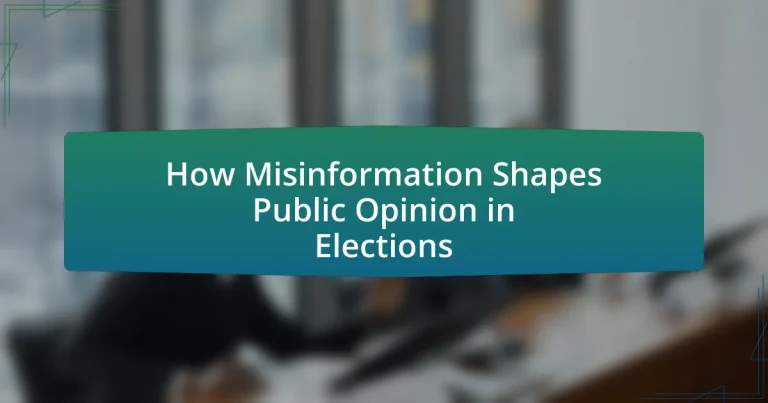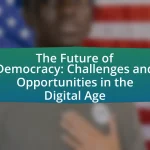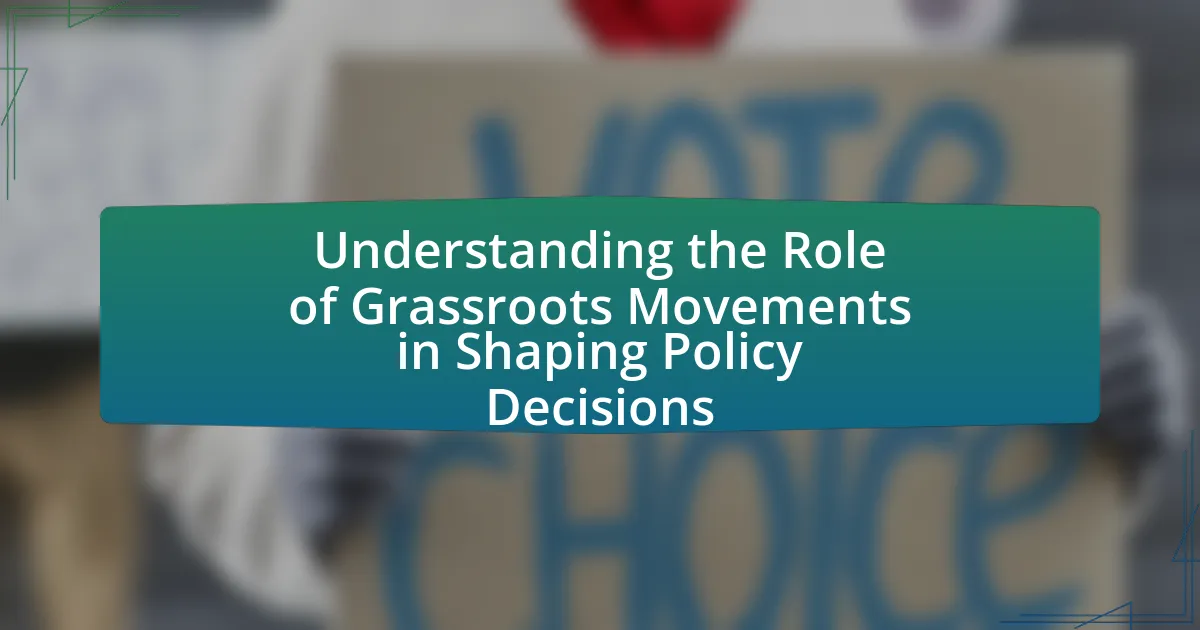Misinformation plays a critical role in shaping public opinion during elections by influencing perceptions of candidates and issues, often leading to altered voting preferences. Key sources of misinformation include social media platforms, partisan news outlets, and political advertising, which contribute to the rapid spread of false narratives. Cognitive biases, such as confirmation bias, and social influences drive individuals to believe and share misinformation, further complicating the electoral landscape. The consequences of misinformation include decreased voter turnout and skewed perceptions of candidates, ultimately affecting electoral outcomes. Strategies to combat misinformation involve fact-checking initiatives, public awareness campaigns, and collaborative efforts between social media companies, governments, and NGOs to promote media literacy and transparency.

How does misinformation influence public opinion during elections?
Misinformation significantly influences public opinion during elections by shaping perceptions and beliefs about candidates and issues. Studies indicate that exposure to false information can lead to altered voting preferences, as individuals often rely on misleading narratives to form their opinions. For instance, research published in the journal “Political Communication” found that misinformation can decrease trust in political institutions and increase polarization among voters. This effect is exacerbated by social media platforms, where misinformation spreads rapidly, reaching large audiences and reinforcing existing biases.
What are the primary sources of misinformation in electoral contexts?
The primary sources of misinformation in electoral contexts include social media platforms, partisan news outlets, and political advertising. Social media platforms, such as Facebook and Twitter, facilitate the rapid spread of false information due to their vast reach and user-generated content. A study by the Pew Research Center found that 64% of Americans believe that social media has a significant role in the spread of misinformation during elections. Partisan news outlets often present biased information that aligns with specific political agendas, further contributing to misinformation. Additionally, political advertising can disseminate misleading claims about candidates or policies, as evidenced by the increase in fact-checking efforts during election cycles, which highlight numerous instances of false statements in campaign ads.
How do social media platforms contribute to the spread of misinformation?
Social media platforms contribute to the spread of misinformation by enabling rapid dissemination of false information to vast audiences. The algorithms used by these platforms often prioritize engagement over accuracy, leading to sensational or misleading content being shared more widely than factual information. For instance, a study by the Massachusetts Institute of Technology found that false news stories are 70% more likely to be retweeted than true stories, highlighting the platforms’ role in amplifying misinformation. Additionally, the lack of stringent fact-checking mechanisms allows misleading content to proliferate unchecked, further influencing public opinion, especially during critical events like elections.
What role do traditional media outlets play in disseminating misinformation?
Traditional media outlets play a significant role in disseminating misinformation by amplifying false narratives and unverified claims. This amplification occurs through the prioritization of sensational stories over fact-checked reporting, often driven by the need for higher viewership and engagement. For instance, a study by the Pew Research Center found that 64% of Americans believe that fabricated news stories cause confusion about basic facts, indicating the impact of traditional media in shaping public perception. Furthermore, during election cycles, traditional media can inadvertently spread misinformation by failing to adequately vet sources or by presenting biased coverage, which can influence voter opinions and behaviors.
Why do individuals believe and share misinformation?
Individuals believe and share misinformation primarily due to cognitive biases and social influences. Cognitive biases, such as confirmation bias, lead individuals to favor information that aligns with their pre-existing beliefs, making them more likely to accept and disseminate false information that supports their views. Social influences, including group dynamics and the desire for social acceptance, further encourage the sharing of misinformation, as individuals often seek validation from their peers. Research indicates that misinformation spreads more rapidly in social networks, with studies showing that false news stories are 70% more likely to be retweeted than true stories, highlighting the significant role of social media in amplifying these effects.
What psychological factors drive the acceptance of false information?
Cognitive biases, social influences, and emotional responses drive the acceptance of false information. Cognitive biases, such as confirmation bias, lead individuals to favor information that aligns with their pre-existing beliefs, making them more likely to accept false claims that support their views. Social influences, including groupthink and the desire for social acceptance, can pressure individuals to conform to the beliefs of their peers, even if those beliefs are based on misinformation. Emotional responses, particularly fear and anger, can also enhance the acceptance of false information, as emotionally charged content is often more memorable and persuasive. Research by Lewandowsky et al. (2012) in “Misinformation and Its Correction: Continued Influence and Successful Debiasing” highlights how these psychological factors contribute to the persistence of false beliefs, demonstrating that misinformation can be more readily accepted when it resonates emotionally or socially with individuals.
How does confirmation bias affect the sharing of misinformation?
Confirmation bias significantly influences the sharing of misinformation by leading individuals to favor information that aligns with their pre-existing beliefs while disregarding contradictory evidence. This cognitive bias causes people to selectively seek out, interpret, and share information that confirms their views, thereby amplifying the spread of false narratives. Research indicates that individuals are more likely to share misinformation that resonates with their political affiliations, as demonstrated in a study published in the journal “Science” by Vosoughi, Roy, and Aral, which found that false news stories are 70% more likely to be retweeted than true stories. This tendency not only perpetuates misinformation but also reinforces group polarization, ultimately shaping public opinion in elections.

What are the consequences of misinformation on electoral outcomes?
Misinformation significantly alters electoral outcomes by influencing voter perceptions and behaviors. Studies indicate that exposure to false information can lead to decreased voter turnout, as individuals may feel disillusioned or confused about the electoral process. For instance, a 2017 study published in the journal “Political Communication” found that misinformation about voting procedures led to a 5% drop in turnout among affected demographics. Additionally, misinformation can skew public opinion by promoting false narratives about candidates, which can shift voter preferences and ultimately affect election results. The 2016 U.S. presidential election exemplified this, where misleading information circulated on social media platforms contributed to polarized views and influenced voter decisions.
How does misinformation affect voter behavior and decision-making?
Misinformation significantly alters voter behavior and decision-making by creating confusion and influencing perceptions of candidates and issues. Studies indicate that exposure to false information can lead voters to make decisions based on incorrect beliefs, ultimately affecting election outcomes. For instance, research published in the journal “Nature” by Vosoughi, Roy, and Aral in 2018 found that false news spreads more rapidly on social media than true news, leading to widespread misconceptions among the electorate. This distortion of information can result in voters supporting candidates or policies that do not align with their actual preferences or values, thereby undermining the democratic process.
What impact does misinformation have on voter turnout?
Misinformation significantly decreases voter turnout by creating confusion and distrust among potential voters. Studies indicate that exposure to false information can lead to apathy and disengagement from the electoral process. For instance, a 2020 study published in the journal “Political Behavior” found that individuals who encountered misinformation about voting procedures were 20% less likely to participate in elections. This decline in turnout is often attributed to the belief that their votes may not matter or that the electoral process is compromised, ultimately undermining democratic participation.
How can misinformation alter perceptions of candidates and policies?
Misinformation can significantly alter perceptions of candidates and policies by creating false narratives that influence public opinion. For instance, studies have shown that exposure to misleading information can lead voters to form negative opinions about candidates based on fabricated claims, such as false allegations of misconduct or misrepresentation of policy positions. Research conducted by the Pew Research Center indicates that 64% of Americans believe that misinformation has a major impact on their understanding of political issues. This distortion of facts can result in decreased trust in candidates and increased polarization among voters, ultimately affecting electoral outcomes.
What strategies do political campaigns use to combat misinformation?
Political campaigns combat misinformation through fact-checking, public engagement, and strategic messaging. Fact-checking involves verifying claims made by opponents or in media to provide accurate information to the public, as seen in initiatives by organizations like PolitiFact and FactCheck.org. Public engagement strategies include direct communication with voters via social media and town halls, allowing campaigns to address misinformation in real-time and clarify their positions. Additionally, campaigns utilize strategic messaging to frame narratives that counter false information, often employing targeted advertisements that highlight factual data and reinforce their message. These strategies are essential in maintaining voter trust and ensuring informed decision-making during elections.
How effective are fact-checking initiatives in reducing misinformation’s impact?
Fact-checking initiatives are effective in reducing the impact of misinformation, as evidenced by studies showing that they can significantly alter public perceptions and beliefs. For instance, a study published in the journal “Science” found that exposure to fact-checks can decrease the likelihood of individuals believing false claims by up to 20%. Additionally, research from the Pew Research Center indicates that 64% of Americans believe that fact-checking helps clarify the truth about political issues. These findings demonstrate that fact-checking initiatives play a crucial role in mitigating the spread and influence of misinformation, particularly during elections.
What role do public awareness campaigns play in educating voters?
Public awareness campaigns play a crucial role in educating voters by providing accurate information about electoral processes, candidates, and issues. These campaigns aim to counter misinformation and enhance voter engagement by disseminating facts through various media channels. For instance, studies have shown that targeted public awareness initiatives can increase voter turnout by as much as 10% by informing citizens about their voting rights and the importance of participation in elections. This effectiveness is evidenced by the success of campaigns like “Rock the Vote,” which has mobilized millions of young voters through educational outreach.

How can individuals and organizations mitigate the effects of misinformation in elections?
Individuals and organizations can mitigate the effects of misinformation in elections by promoting media literacy and fact-checking initiatives. Media literacy programs educate voters on how to critically evaluate sources and discern credible information from falsehoods. For instance, studies show that individuals exposed to media literacy training are better equipped to identify misinformation, leading to more informed voting decisions. Organizations can also implement fact-checking services that verify claims made during campaigns, as seen with initiatives like PolitiFact and FactCheck.org, which have successfully debunked numerous false statements in political discourse. By fostering a culture of critical thinking and providing accessible fact-checking resources, both individuals and organizations can significantly reduce the impact of misinformation on electoral outcomes.
What best practices can voters adopt to identify misinformation?
Voters can adopt several best practices to identify misinformation, including verifying sources, cross-referencing information, and being skeptical of sensational claims. Verifying sources involves checking the credibility of the information provider, such as established news organizations or fact-checking websites. Cross-referencing information means comparing multiple reputable sources to confirm the accuracy of a claim. Additionally, being skeptical of sensational claims helps voters recognize potential exaggerations or falsehoods, as research indicates that emotionally charged content is often misleading. For instance, a study by the Pew Research Center found that misinformation spreads more rapidly on social media platforms, highlighting the importance of critical evaluation of online content.
How can critical thinking skills help in evaluating information sources?
Critical thinking skills enhance the ability to evaluate information sources by enabling individuals to analyze, assess, and synthesize information critically. These skills allow individuals to discern the credibility of sources, identify biases, and evaluate the validity of arguments presented. For instance, a study published in the Journal of Educational Psychology found that individuals trained in critical thinking demonstrated improved skills in assessing the reliability of information, leading to better decision-making in contexts such as political elections. This ability to critically evaluate sources is essential in combating misinformation, as it empowers individuals to make informed choices based on accurate and reliable information.
What tools and resources are available for fact-checking information?
Fact-checking tools and resources include websites like Snopes, FactCheck.org, and PolitiFact, which provide verified information on various claims. These platforms utilize a team of researchers and journalists to investigate the accuracy of statements made by public figures and media. For instance, Snopes has been operational since 1994 and has established a reputation for thorough research and reliable conclusions, making it a trusted source for debunking misinformation. Additionally, tools like Google Fact Check Explorer allow users to search for fact-checked claims across multiple sources, enhancing transparency and accountability in information dissemination.
What collaborative efforts can be made to address misinformation in elections?
Collaborative efforts to address misinformation in elections include partnerships between social media platforms, fact-checking organizations, and governmental bodies. Social media companies can implement algorithms to detect and flag false information, while fact-checkers can provide verified information and context to users. For instance, during the 2020 U.S. elections, platforms like Facebook and Twitter collaborated with organizations such as the Associated Press and FactCheck.org to label misleading posts and direct users to credible sources. This approach not only reduces the spread of misinformation but also enhances public trust in the electoral process by promoting transparency and accountability.
How can social media companies improve their policies to limit misinformation spread?
Social media companies can improve their policies to limit misinformation spread by implementing stricter content moderation practices and enhancing transparency in their algorithms. Stricter content moderation can involve employing advanced AI tools to detect and flag false information, as evidenced by Facebook’s use of third-party fact-checkers, which has led to a reduction in the visibility of misleading posts by 80% in some cases. Enhancing transparency means clearly communicating how content is prioritized and providing users with context about the sources of information, which can help users critically evaluate the content they encounter. Additionally, social media platforms can collaborate with credible organizations to promote media literacy initiatives, empowering users to identify misinformation effectively.
What partnerships can be formed between governments and NGOs to combat misinformation?
Governments and NGOs can form partnerships focused on information sharing, public education campaigns, and collaborative research initiatives to combat misinformation. For instance, governments can provide NGOs with access to data on misinformation trends, enabling NGOs to develop targeted educational programs that inform the public about identifying false information. Additionally, joint initiatives can include fact-checking collaborations, where NGOs verify claims made during elections, thus enhancing the credibility of information disseminated to the public. Research shows that such partnerships can significantly reduce the spread of misinformation; for example, a study by the Pew Research Center found that fact-checking efforts led by NGOs in collaboration with governmental bodies increased public awareness and skepticism towards misleading information during electoral processes.




